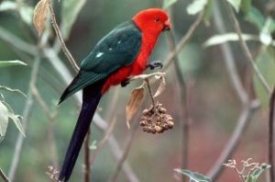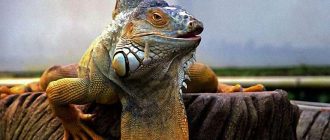Caring for Australian Parrots? Learn more about the fascinating king Australian Parrot, which is native to eastern Australia…
Australian parrots are known all over the world for their beauty and companionship characteristics. Their home is based in the heavy rain forests and humid regions of eastern Australia. There are many eucalyptus plantations along with heavily wooded areas which lie adjacent to the temperate rainforest and subtropical regions.
The parrots are known to maintain a diet of small insects, seeds and fruits. In terms of taxonomic classification the Australian King Parrot was first classified in 1818 by Martin Lichtenstein who was a German naturalist. The species has been classified under the genus Alisterus. This category has three basic members which are known as the Australian king parrots. Sometimes this genus is mixed with the genus Aprosmictus. There are two identified subspecies and each is differentiated only by its size. The Alisterus scapularis was identified and classified in 1816 while the Alisterus scapularis minor was classified in 1911, followed by the final classification of the Alisterus scapularis scapularis also in 1816.
Description of the Australian Parrots
At adulthood both the genders have a maximum height of 17 inches, which covers the long and very broad tail. The plumage and colour of the adult male includes a red breast, head and lower portions of the underside. It has a blue band lying on the back of the neck and this falls directly in the centre of the red head and green back. Each of the green wings has the pale green shoulder band while the rump is blue in colour and the tail is green. The upper mandible of the male king Australian parrot is reddish-orange and ends with a black tip. In contrast the lower mandible is black and has an orange base, and yellow irises to finish it off.
Plumage of the Female King Australian Parrot
The female has a different plumage altogether and is immediately noticeable in contrast to the male. With a green breast and head that is finished off with a grey beak, the shoulder band is either very small or completely missing.
Description of Young Australian Parrots
The young Australian parrots of either gender have a pale yellow beak and brown irises. Otherwise the juveniles resemble the female in all other aspects
Subspecies across Australia
There are two basic subspecies; the A. s. minor is located in the northern limit of the species range. It is quite similar in terms of its appearance to the nominate subspecies but has a smaller size. Its maximum length is smaller by 2 inches when compared to the others.
Habitat and Distribution of Australian Parrots
Australian King Parrots are available in the vast land area in Australia. This includes the region of central Queensland all the way to the north of Queensland and spreads continuously towards Southern Victoria. Found in small groups and in close proximity to different species of rosella, they are also seen further upland towards the east in Canberra mainly during the winters. Winter sees the population migrating to the Carnarvon Gorge in Central Queensland and the north shore of Sydney.





